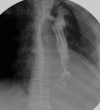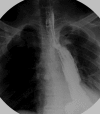Fluoroscopically guided nose tube drainage of mediastinal abscesses in post-operative gastro-oesophageal anastomotic leakage
- PMID: 22806622
- PMCID: PMC3500790
- DOI: 10.1259/bjr/53905073
Fluoroscopically guided nose tube drainage of mediastinal abscesses in post-operative gastro-oesophageal anastomotic leakage
Abstract
Objective: The aim of this study was to retrospectively evaluate the technical success rates and clinical effectiveness of fluoroscopically guided nose tube drainage of mediastinal abscesses and a nasojejunum feeding tube in post-operative gastro-oesophageal anastomotic leakage (GEAL).
Methods: From January 2006 to June 2011, 18 cases of post-operative GEAL with mediastinal abscesses after oesophagectomy with intrathoracic oesophagogastric anastomotic procedures for oesophageal and cardiac carcinoma were treated by insertion of a nose drainage tube and nasojejunum feeding tube under fluoroscopic guidance. We evaluated the feasibility of two-tube insertion to facilitate leakage site closure and complete resolution of the abscess, and the patients' nutritional benefit was also evaluated by checking the serum albumin level between pre- and post-enteral feeding via the feeding tube.
Results: The two tubes were placed successfully under fluoroscopic guidance in 18 patients (100%). The procedure time for two-tube insertion ranged from 20 to 40 min (mean 30 min). 17 patients (94%) achieved leakage site closure after two-tube insertion and had a good tolerance of two tubes in the nasal cavity. The serum albumin level was significant, increased from pre-enteral feeding (2.49 ± 0.42 g dl(-1)) to the post-enteral feeding (3.58 ± 0.47 g dl(-1)) via the feeding tube (p<0.001). The duration of follow-up ranged from 1 to 49 months (mean 19 months).
Conclusion: The insertion of nose tube drainage and a nasojejunum feeding tube under fluoroscopic guidance is safe, and it provides effective relief from mediastinal abscesses in GEAL after oesophagectomy. Moreover, our findings indicate that two-tube insertion may be used as a selective procedure to treat mediastinal abscesses in post-operative GEAL. Advances in knowledge Directive drainage of mediastinal abscesses in post-operative GEAL may be an effective treatment.
Figures





Similar articles
-
Fluoroscopically guided three-tube insertion for the treatment of postoperative gastroesophageal anastomotic leakage.Korean J Radiol. 2012 Mar-Apr;13(2):182-8. doi: 10.3348/kjr.2012.13.2.182. Epub 2012 Mar 7. Korean J Radiol. 2012. PMID: 22438685 Free PMC article.
-
Fluoroscopically guided feeding tube insertion for relief of postoperative gastrointestinal anastomotic obstruction and leakage.Cardiovasc Intervent Radiol. 2006 May-Jun;29(3):395-400. doi: 10.1007/s00270-005-0095-z. Cardiovasc Intervent Radiol. 2006. PMID: 16502160
-
Interventional radiology protocol for treatment of esophagogastric anastomotic leakage.Radiol Med. 2019 Dec;124(12):1253-1261. doi: 10.1007/s11547-019-01074-0. Epub 2019 Aug 19. Radiol Med. 2019. PMID: 31428958
-
Treatment of intrathoracic anastomotic leak after esophagectomy with the sump drainage tube.J Cardiothorac Surg. 2021 Mar 23;16(1):46. doi: 10.1186/s13019-021-01429-7. J Cardiothorac Surg. 2021. PMID: 33757562 Free PMC article.
-
Thoracic intervention.Curr Opin Radiol. 1992 Oct;4(5):94-103. Curr Opin Radiol. 1992. PMID: 1343949 Review.
Cited by
-
Management of postoperative gastrointestinal leakage with autologous stromal vascular fraction.Int Surg. 2015 Apr;100(4):748-54. doi: 10.9738/INTSURG-D-14-00120.1. Int Surg. 2015. PMID: 25875560 Free PMC article.
-
[Endoscopic trans-fistula drainage for gastroesophageal anastomotic fistula with para-fistula abscess after esophagectomy].Zhejiang Da Xue Xue Bao Yi Xue Ban. 2017 May 25;46(6):637-642. doi: 10.3785/j.issn.1008-9292.2017.12.10. Zhejiang Da Xue Xue Bao Yi Xue Ban. 2017. PMID: 29658667 Free PMC article. Chinese.
References
-
- Patil PK, Patel SG, Mistry RC, Deshpande RK, Desai PB. Cancer of the esophagus: esophagogastric anastomotic leak-a retrospective study of predisposing factors. J Surg Oncol 1992;49:163–7 - PubMed
-
- Dewar L, Gelfand G, Finley RJ, Evans K, Inculet R, Nelems B. Factors affecting cervical anastomotic leak and stricture formation following esophagogastrectomy and gastric tube interposition. Am J Surg 1992;163:484–9 - PubMed
-
- Urschel JD. Esophagogastrectomy anastomotic leaks complicating esophagectomy: a review. Am J Surg 1995;169:634–40 - PubMed
-
- Sauvanet A, Baltar J, Le Mee J, Belghiti J. Diagnosis and conservative management of intrathoracic leakage after oesophagectomy. Br J Surg 1998;85:1446–9 - PubMed
MeSH terms
LinkOut - more resources
Full Text Sources
Medical

